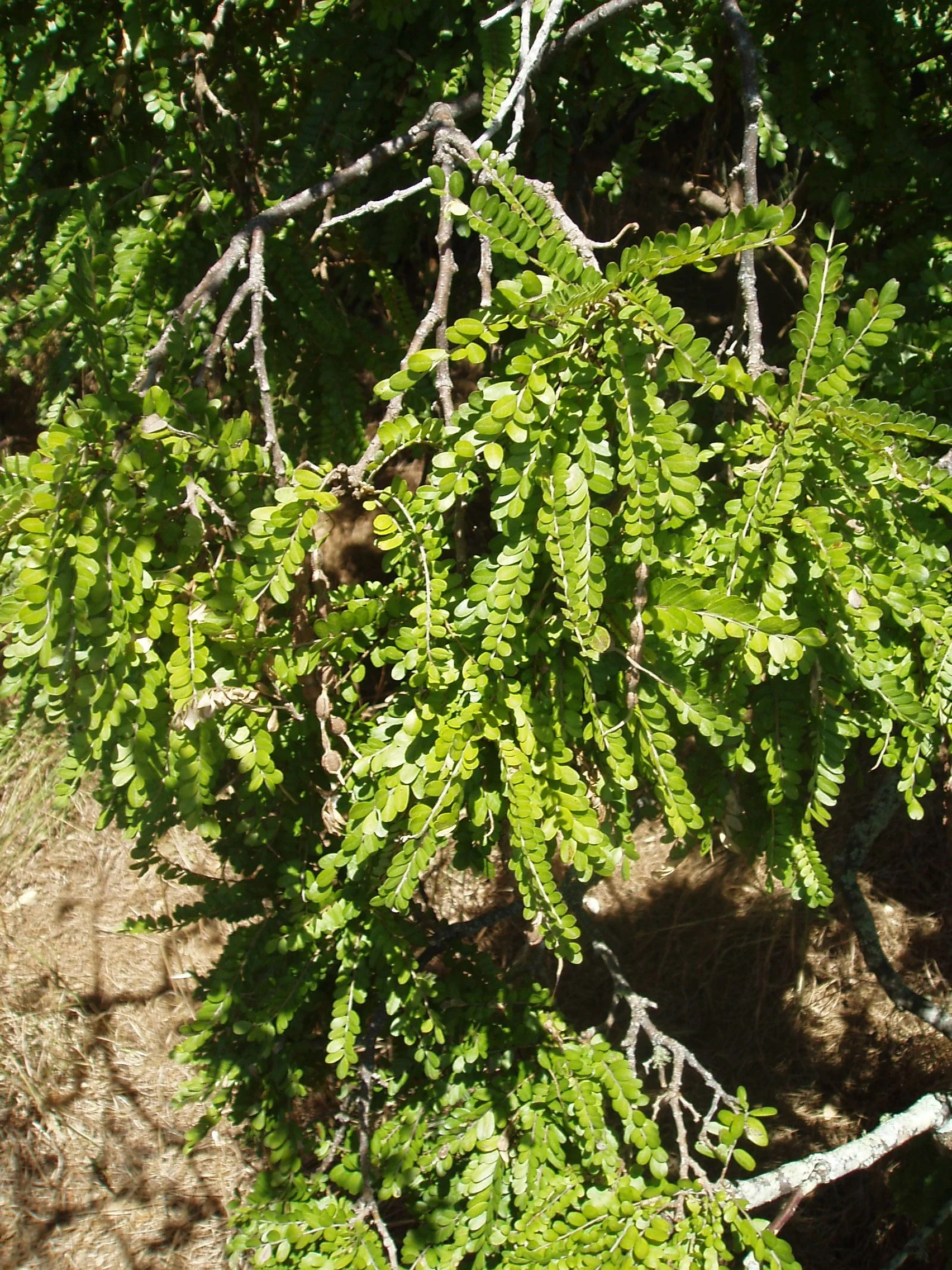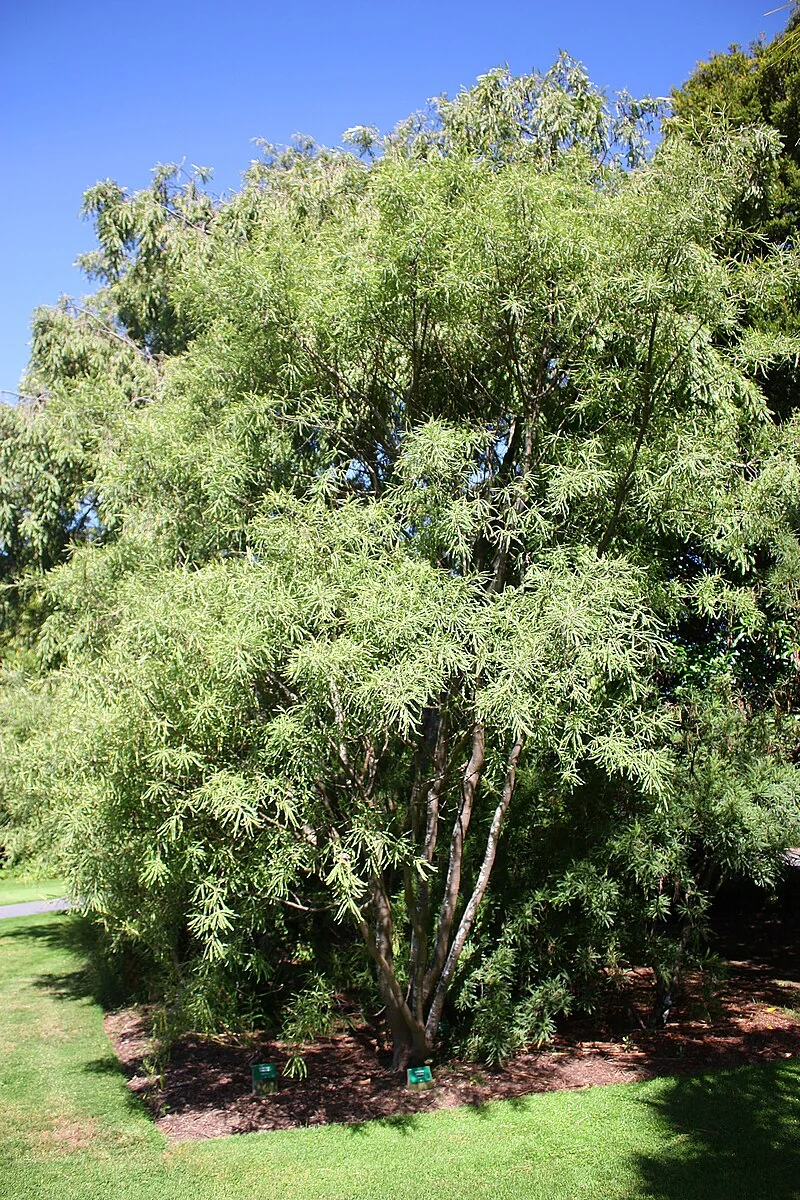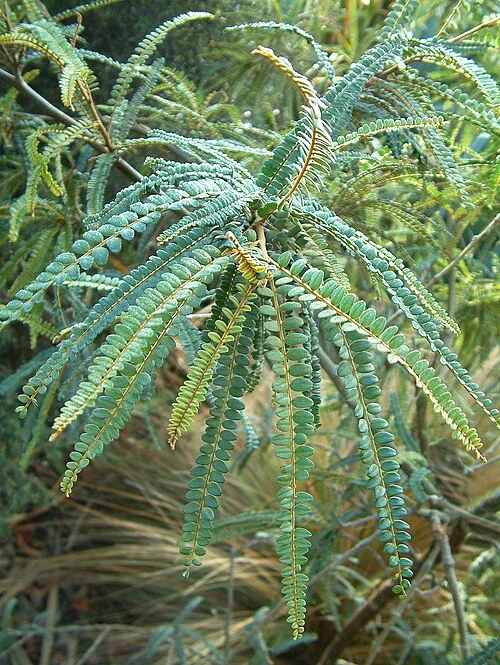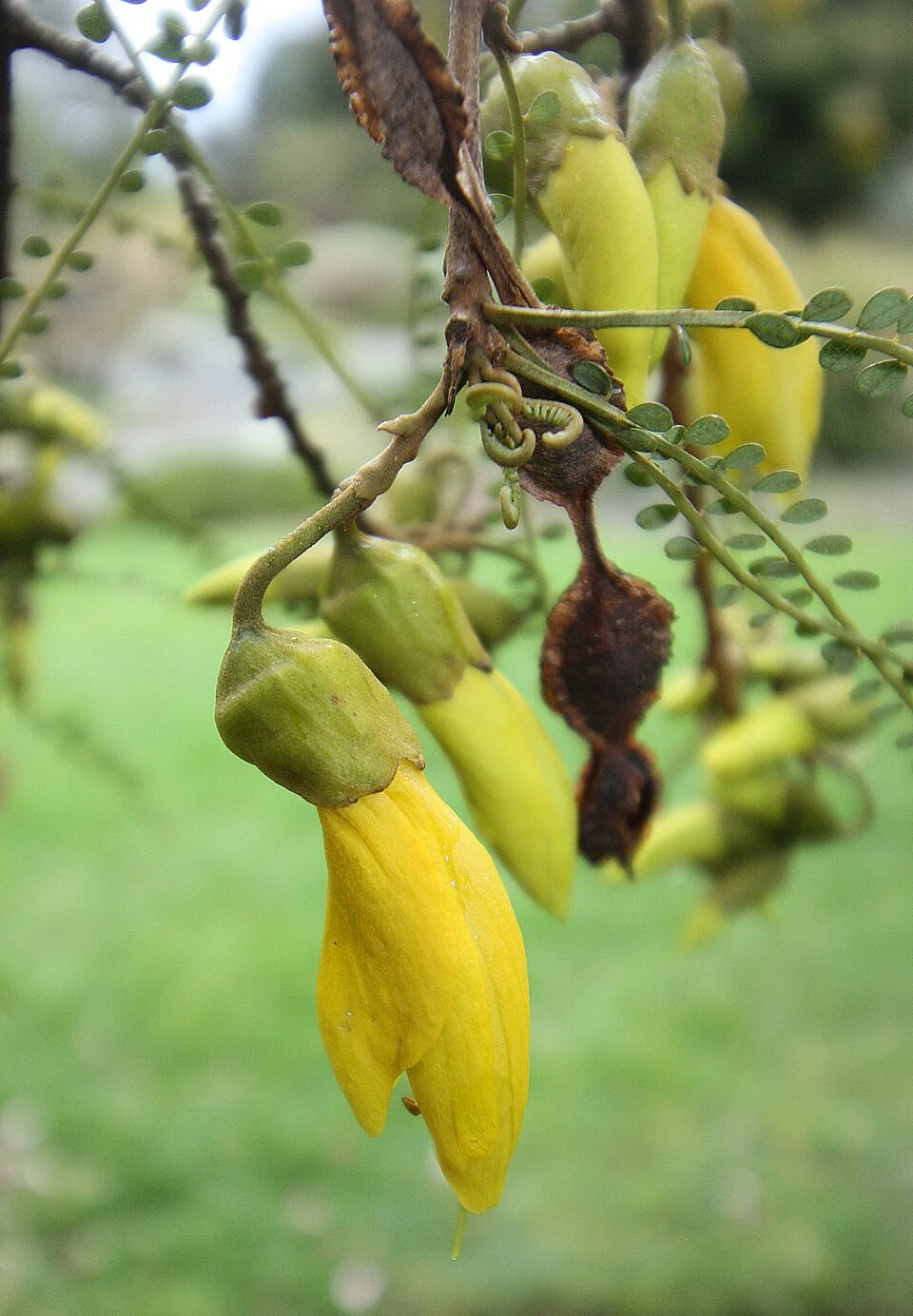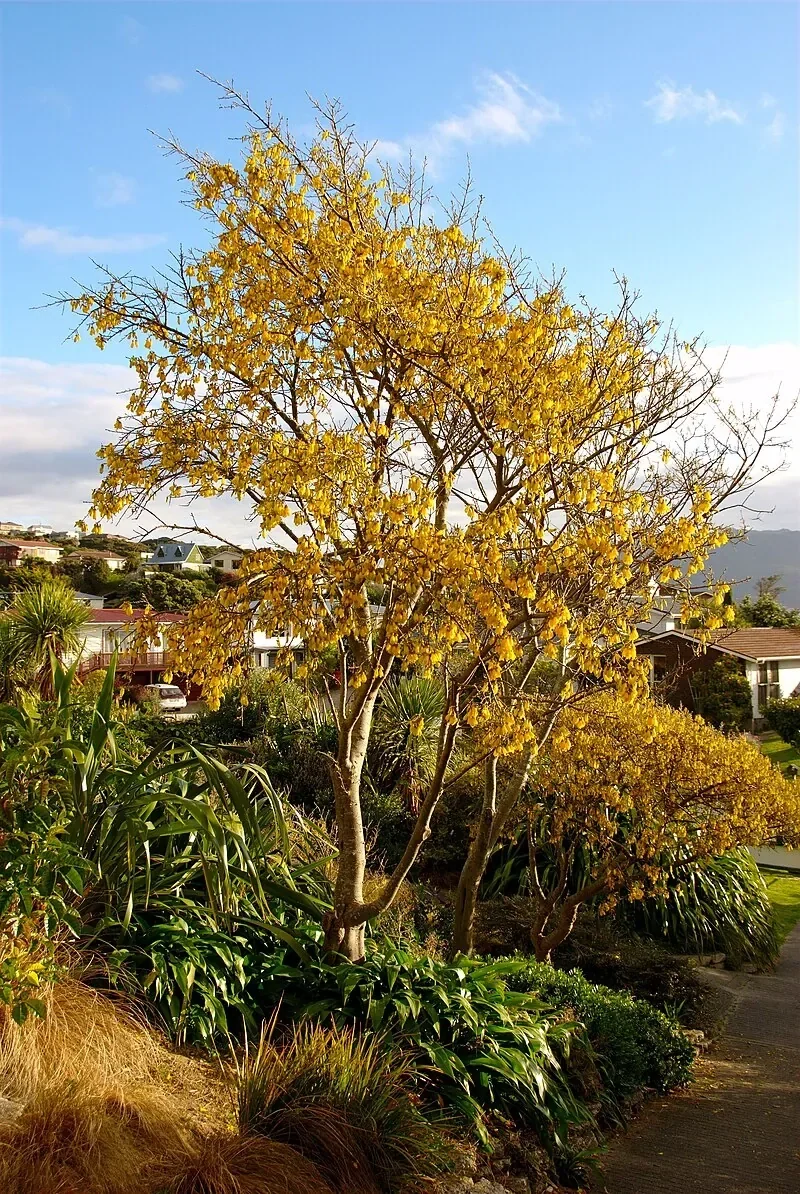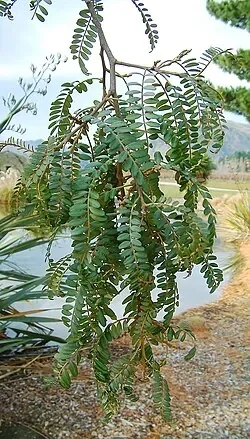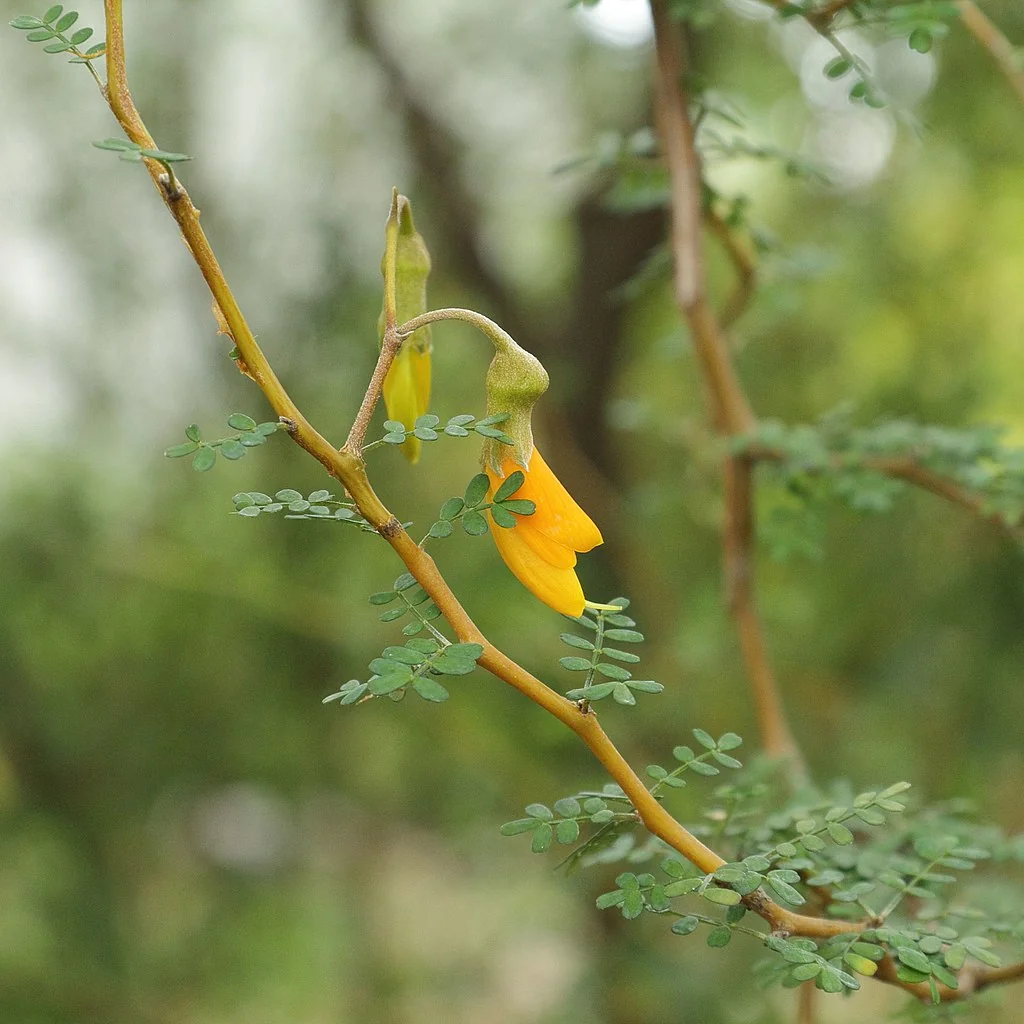
Prostrate Kōwhai
Sophora prostrata
Sophora prostrata , commonly known as Prostrate Kōwhai or Dwarf Kōwhai, is a distinctive endemic shrub confined to the eastern South Island of New Zealand, from Marlborough to the Waitaki Valley. This remarkable species grows up to 2 meters tall and is characterized by its persistent divaricating (zigzagging) growth habit with highly interlaced, wiry branches that create a dense, tangled structure. The small leaves, reaching up to 25mm long with tiny 4mm leaflets, are complemented by yellow-orange yellow-distinctive This exceptionally hardy species thrives in the harsh conditions of dry grassland and rocky outcrops, demonstrating remarkable tolerance to drought, wind, and extreme temperatures.

Plant Description
The wood and branchlets of Sophora prostrata are unusually rigid and strong for the genus, forming a dense, tangled, zig-zagging structure. This distinctive feature is widely interpreted as an evolutionary adaptation linked to protection from browsing, possibly by the extinct moa, allowing the plant to persist in harsh environments.
Quick Facts
| Scientific Name | Sophora Prostrata |
|---|---|
| Common Name | Kōwhai |
| Plant Type | Small, dense, semi-deciduous shrub |
| Height | Around 2 meters |
| Spread | 1-1.5 meters wide |
| Growth Habit | Divaricating (zigzagging), wiry and tangled branches |
| Leaves | Small (up to 2 cm), leaflets around 4mm |
| Flowers | flowering |
| Flowering Time | Late winter to spring (July - November) |
| Seeds | Black (distinctive among kōwhai species), in ridged and knobbly pointed pods to 5cm long |
| Habitat | Eastern South Island of New Zealand, Banks Peninsula |
| Water Needs | low-Nt once established |
| Light | Full sun |
| Soil | Very well-drained, lean soil preferred |
| Frost Tolerance | Hardy to mild frost (USDA zones 8-11) |
| Hardiness | USDA zones 8-11, hardy to mild frost |
| Special Features | low-maintenance |
| Family | Fabaceae (Legume family) |
| Mature Size | Up to 2 m tall, 1-1.5 m wide |
| Uses | Rock gardens, borders, coastal gardens, container growing, restoration projects |
| Salt Tolerance | High; tolerates coastal salt spray and harsh conditions |
| Growth Rate | Moderate to fast; reaches maturity in 10-15 years |
| Lifespan | Long-lived perennial shrub with persistent structure |
Climate Best Suited to
low rainfall It tolerates light to moderate frost once established and prefers free-draining soils with good air movement; humidity is not required.
Regional Suitability
| City | Climate Suitability |
|---|---|
| Whangārei | Ideal |
| Auckland | Ideal |
| Hamilton | Ideal |
| Tauranga | Ideal |
| Rotorua | Ideal |
| Gisborne | Ideal |
| New Plymouth | Ideal |
| Napier | Ideal |
| Whanganui | Ideal |
| Palmerston North | Ideal |
| Wellington | Ideal |
| Nelson | Ideal |
| Christchurch | Ideal |
| Dunedin | Ideal |
| Invercargill | Ideal |
Natural Habitat
Occurs on dry hill country, limestone and loess soils, terraces and river flats from Marlborough to North Otago. Found in open scrub, rocky outcrops and forest margins exposed to wind and seasonal drought. The dense divaricating canopy shades its own roots and suppresses competing herbs.
Plant Conservation
Conservation Status
The conservation status of Sophora prostrata was reassessed in 2022-2023 and classified as "At Risk - Declining" under the New Zealand Threat Classification System, representing a significant change from its previous "Not Threatened" status. This reclassification reflects growing concerns about population decline and habitat pressures.
Threats and Challenges
The species faces ongoing pressure from habitat loss due to urban development, agricultural expansion, and invasive species encroachment in its restricted eastern South Island range. Its specialized habitat requirements and slow-Nt make natural recovery challenging in disturbed areas.
Ecological Importance
As a member of the legume family, Sophora prostrata plays a crucial ecological role by fixing nitrogen in the soil, enriching poor soils and benefiting surrounding plant communities. The species provides essential food sources for native birds and insects, contributing to the biodiversity of New Zealand's eastern South Island ecosystems.
Hybridization
In its South Island range, Sophora prostrata can hybridize with Sophora microphylla and Sophora longicarinata , contributing to the genetic diversity within the kōwhai complex and demonstrating the dynamic evolutionary processes still occurring in New Zealand's flora.
How to Grow
Planting Guide
Best Planting Practices
Plant in autumn or early spring into well-prepared, sharply drained ground. Tease roots lightly, set crown level with soil, and mulch with gravel or coarse bark to keep the root zone dry. Space 1-1.5 m apart for hedging or structural accents. Avoid rich nitrogen fertilisers which encourage lank growth.
Ecology
Sophora prostrata is a divaricating kōwhai from the dry, inland eastern South Island, naturally occurring on rocky hillsides, river terraces and limestone outcrops from North Canterbury to North Otago. Its dense, interlaced branchlets and tiny leaflets are widely interpreted as an anti-browsing adaptation that evolved under moa browsing pressure. In late winter to spring the shrub bears small, rich orange-yellow kōwhai flowers that supply nectar and pollen to korimako/bellbird, tūī, and native bees and hoverflies. Plants are drought-tolerant once established and withstand high wind and coastal exposure, adding structure and cover in open, low-shrub communities of the eastern rain shadow.
Uses
A superb architectural shrub for dry gardens, gravel plantings and rockeries, where its intricate tracery provides year‑round texture. It forms a compact, stock‑proof hedge in windy, coastal situations and suits narrow borders, courtyard containers, and even bonsai. The distinctive divaricating habit contrasts beautifully with fine grasses and silver foliage plants, while spring flowers add seasonal colour and wildlife value.
Landscaping Ideas
Use as architectural contrast against fine-textured grasses (Chionochloa, Festuca) or silver Astelia. Its rigid tracery reads well in winter; position near paths for close viewing. Works in dry gravel gardens with Olearia and Muehlenbeckia astonii.
Seasonal Care
Spring
Plant, light feed with low, watch for caterpillars.
Summer
Deep, infrequent watering in drought; no overhead irrigation needed.
Autumn
Mulch with gravel; remove lank seedlings nearby to retain form.
Winter
Protect juveniles from severe frost in very cold sites.
Pruning
Pruning Techniques
Prune lightly to preserve the natural divaricating framework. Tip‑prune after flowering to maintain density, removing long, wayward shoots that break the outline. Avoid hard cutting into old wood, which is slow to reshoot. Remove congested or rubbing twigs to improve airflow and trim out any non‑divaricating reversion growth if it appears.
How to Grow Prostrate Kōwhai
Prostrate Kōwhai grows best when you match its natural rocky, well-drained habitat requirements. This small, dense kōwhai requires excellent drainage and tolerates harsh conditions including drought, wind, and poor soils. Site selection is crucial for success, as waterlogged or heavy clay soils will prove fatal to this specialized species. Choose elevated, sunny positions that receive good air circulation and protection from excessive moisture during winter months when the plant is most vulnerable to root rot.
Seed
Prostrate Kōwhai produces distinctive dry, ridged seed pods up to 5cm long that should be collected when fully mature and beginning to split naturally. Extract seeds and treat with scarification by nicking or filing the hard seed coat to improve germination rates, as kōwhai seeds have notoriously hard coats that can remain dormant for years without treatment. Alternatively, briefly soak seeds in hot water for 24 hours before sowing. Sow treated seed immediately onto a free-draining seed-raising mix, covering lightly with fine grit to maintain moisture while preventing fungal issues. Keep evenly moist in bright, indirect light away from harsh afternoon sun, maintaining temperatures around 18-22°C for optimal germination. Germination timing varies considerably from 2-12 weeks depending on seed treatment effectiveness and environmental conditions. Young seedlings grow slowly initially but develop strong taproot systems that make them excellent candidates for challenging sites once established.
Cuttings
Semi-hardwood cuttings can be taken from healthy current-season growth during late spring to early summer when shoots have begun to firm up. Select non-flowering shoots 8-12cm long and remove lower leaves to reduce transpiration. Kōwhai species can be challenging to root, so use a well-drained propagation mix with added perlite and apply rooting hormone to encourage success. Maintain high humidity under plastic covers or in a propagation house, providing bottom heat at 20-22°C if possible. Ventilate gradually as root development occurs, typically within 8-12 weeks for successful cuttings. Success rates are often lower than seed propagation, making this method less reliable for home gardeners.
Establishment Care
Young Prostrate Kōwhai plants require careful establishment in well-drained positions that replicate their natural rocky habitat. Dig wide planting holes and incorporate coarse gravel or pumice to improve drainage, especially in heavier soils. Set plants at their original depth and backfill with a free-draining mixture, watering gently to settle soil around roots. Mulch with gravel or stones rather than organic materials to prevent moisture retention around the crown. Protect from strong winds and extreme weather during the first growing season, but avoid overwatering as this species is highly drought-tolerant once established. Feed very lightly if at all, as excessive nutrition can encourage soft growth that compromises the plant's natural hardiness and distinctive compact form.
Pests and Diseases
Common Problems and Solutions
Generally tough in well‑drained sites. Kōwhai moth caterpillars (Uresiphita maorialis) can defoliate shoots in late spring-hand pick or use biological controls if damage is heavy. Scale insects and aphids may colonise soft growth, leading to sooty mould; manage with horticultural oils and improved airflow. The main risk is root rot in waterlogged soils-plant high, amend with grit, and avoid overwatering. Young plants may be browsed by rabbits or hares; use guards where pressure is high.
Cultural Significance
Traditional Uses and Values
Sophora prostrata , commonly known as Prostrate Kōwhai or Dwarf Kōwhai, holds important cultural significance as part of New Zealand's endemic kōwhai group. kōwhai
This species represents a fascinating example of evolutionary adaptation, with scientists speculating that its distinctive divaricating (tangled, zigzagging) growth habit co-evolved with the now-extinct moa, large flightless birds that once browsed on these plants. The dense, interwoven branch structure provided protection from these massive herbivores while still allow-Ng the plant to photosynthesize and reproduce.
Today, Prostrate Kōwhai serves as an important ambassador for New Zealand's unique flora, particularly valued in international horticulture for its distinctive form and hardiness. Its cultivation in rock gardens and specialist collections worldwide helps preserve genetic material and raises awareness of New Zealand's remarkable botanical heritage.
The species also demonstrates the importance of specialized ecological niches in New Zealand's ecosystems, thriving in the harsh, dry conditions of the eastern South Island where few other woody plants can survive, thus playing a crucial role in maintaining the integrity of these unique plant communities.
Bonus Tip
Expert Growing Advice
To cultivate the tightest, most intricately interlaced habit characteristic of Sophora prostrata, ensure it is grown in full sun on lean, stony soils. Once established, avoid summer irrigation; this drier regime promotes the dense, compact form that makes this dwarf kōwhai so distinctive and resilient in challenging environments.
